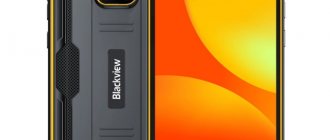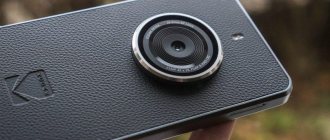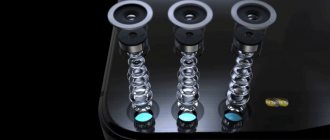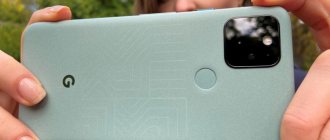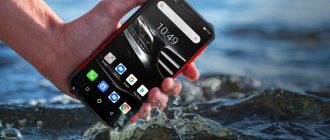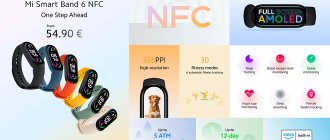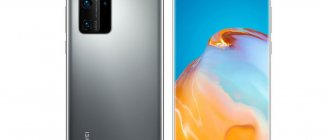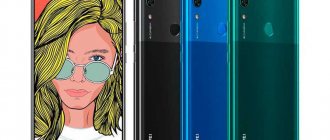Mobile camera modules have a fairly high cost. This is why you will never see the same camera in smartphones costing up to 10 thousand rubles, which is built into top models.
However, one cannot help but note the fact that any electronic equipment becomes cheaper over time. Now even a budget device can shoot better than the flagships of five years ago. And some buyers don’t need more.
Below you will get acquainted with those inexpensive devices that take pictures better than others. By the way, you can read about smartphones with the best front camera in a separate collection.
Samsung Galaxy A22
- Processor: MediaTek Helio G80
- Screen: 6.4″, resolution 1600×720, 90 Hz
- Memory (RAM/built-in): 4/64 or 4/128 GB
- Rear camera:
48 (f/1.80) + 8 (f/2.20) + 2 (f/2.40) + 2 (f/2.40) MP - Front camera: 13 (f/2.0) MP
- Battery: 5000 mAh
Price: from 15,800 rubles
The most attractive smartphone with good cameras in the budget segment is the Galaxy A22 from Samsung. Here we are greeted by a powerful four-camera system, a capacious battery, NFC, a fairly fast processor and a Super AMOLED display with support for a 90 Hz refresh rate.
The main camera on the back of the body has a resolution of 48 MP and optical stabilization. Additional modules include an 8-megapixel wide-angle sensor, a macro lens and a scene depth sensor used in portrait mode. There is no need to squeeze anything out of the cameras; already in automatic mode they produce good pictures in almost any conditions. The 13 MP front module also has a “Bokeh” mode and perfectly defines the contour.
The Galaxy A22 is powered by an 8-core MTK Helio G80 single-chip system. The processor was announced in the first quarter of 2022, so it will be relevant for at least another year and a half to two years, which means you shouldn’t worry about “brakes” and “lags” in the system. A full battery will last for a long time, but the manufacturer has not provided for fast charging.
Advantages:
- Super AMOLED 90 Hz: rich, rich colors and smoothness.
- Fast processor.
- NFC support.
- Battery life.
- Excellent photo quality.
Flaws:
- No fast charging.
- The screen resolution could be higher.
Which smartphone under 30,000 rubles is better to buy in 2022?
| Nomination | Winner |
| Best main camera | Samsung Galaxy A72 |
| Best selfie camera | Samsung Galaxy A52 |
| The highest quality video recording | Samsung Galaxy A72 |
| Lasts the longest on a single charge | Realme 8 Pro |
| With record gaming performance | Poco F3 |
| Leader in price/quality | Poco X3 Pro |
| The most beautiful | Redmi Note 10 Pro |
| With the best screen | Poco F3 |
Rating of the best Power Banks for 20000 mAh in 2022
The best Honor smartphones in 2022 with a good camera
The best gaming PC build for 30,000 rubles - a list of components relevant in 2022
Rating of the most popular smartphones in Russia and the world
The best used car for 300 thousand rubles in 2022 - TOP 6 reliable and affordable cars
The best smartphones 2022 under 9,000 rubles - TOP 10 good budget phones
The best inexpensive and good phones for girls
Rating of the best camera phones 2019-2020
Honor 20e
- Processor: HiSilicon Kirin 710F
- Screen: 6.21″, resolution 2340×1080, 60 Hz
- Memory (RAM/built-in): 4/64 GB
- Rear camera:
24 (f/1.80) + 8 (f/2.40) + 2 (f/2.40) MP - Front camera: 8 MP
- Battery: 3400 mAh
Price: from 13,990 rubles
Right behind the Samsung Galaxy A22 in terms of photography quality is the still fresh Honor 20e model. Despite not the most convincing characteristics on paper, the smartphone has something to surprise. The main feature of the device is the cameras, although the manufacturer has been quite successful in other areas. Perhaps the battery may seem too weak for many people.
The main 24-megapixel sensor copes best with its responsibilities when shooting. Thanks to the presence of artificial intelligence, the smartphone recognizes about 500 scenes and several dozen objects, which allows you to automatically optimize settings for any situation. If you wish, you can take a good panorama using the wide-angle module (8 MP), although the quality will be noticeably worse. There is a function for shooting slow-motion videos at 480fps, a “Bokeh” mode and others. A good camera if you look at it through the prism of a low-cost smartphone.
In terms of autonomy and performance, the Honor 20e is very mediocre. The power of the proprietary Kirin 710F chipset for games will not be enough in most cases, and heavy 3D applications will run at settings no higher than low-medium. And if you like to load your phone and rarely leave it during the day, the battery charge may not be enough. However, 3400 mAh means charging every night.
Advantages:
- Excellent main camera.
- Good display with high dot density.
- There is an NFC module.
- Compact and ergonomic: fits comfortably in your hand.
- Thin and light.
Flaws:
- Not the most capacious battery.
- Micro USB connector.
- Not gaming hardware.
The best smartphones
Let's look at the top 3 smartphones that take the best photos and videos. The cameras and displays of these models are considered the most successful on the market.
Huawei P40 Pro
This is the best camera phone at all price levels. Equipped with a 50 MP wide-angle camera with f = 1.28, multi-directional autofocus and optical stabilization. Additional cameras are a 40 MP ultra-wide-angle with f = 1.8 and phase autofocus, as well as a 12 MP telephoto camera with a 1/3.4” matrix, 5x zoom and an optical stabilizer. Auxiliary settings: RAW, HDR, depth detector. 4K video is shot at 30 and 60 fps, slow motion for 720p frames is 7680 fps, and for 1080p it is 960 fps.
There is a 32 MP selfie camera with f = 2.2, 1/2.8” matrix, autofocus and depth sensing. It is possible to shoot 4K video at 60 fps.
The display is excellent: OLED system with a frequency of 90 Hz, size 6.58”, sRGB spectrum standard.
Pros:
- photo quality in low light conditions;
- 5x image magnification when using a telephoto camera;
- super slow motion effect when shooting slow motion video;
- The display is optimal for both shooting and image editing.
Minuses:
- The smartphone does not support Google services.
Apple iPhone 12 Pro Max
The 12 MP main camera with f = 1.6 is equipped with a phase detection autofocus system and a stabilizer. Additional cameras – 12 MP ultra-wide-angle with f = 2.4 and 1/3.6” matrix, as well as a 12 MP telephoto camera with f = 2.2, 1/3.4” matrix size, phase detection autofocus, optical stabilizer and 2, 5x zoom. Auxiliary functions – RAW, HDR, shooting depth detector. 4K shooting is carried out at speeds of up to 60 fps, with frame sizes of 1080p – up to 240 fps.
The 12 MP selfie camera with f = 2.2 is equipped with a depth detector, a biometric identifier and a gyroscopic stabilizer.
The brightness of the 6.7-inch Super Retina XDR OLED display is 1200 nits.
Advantages:
- a complete set of cameras for shooting in any conditions and with any requirements;
- the presence of a night mode in the selfie camera;
- Dolby Vision format;
- stereo format when recording audio;
- optimal resolution and frame rate when shooting video;
- HDR shooting quality;
- Large display with clear images even on a sunny day.
Flaws:
- the high cost of Apple products.
Samsung Galaxy S21 Ultra
The main camera is 108 MP with f = 1.8 and a 1/1.3” matrix, equipped with phase detection autofocus and an optical stabilizer. An additional 12 MP ultra-wide-angle camera with f = 2.2 and a 1/2.5” matrix provides automatic focusing and stabilizer for video shooting. Supporting functions – RAW and automatic HDR mode. Shooting 4K video at up to 60 fps is flawless. For 1080p size the maximum speed is 240 fps, for 720p – 960 fps. A gyroscopic stabilizer is provided.
The 40 MP selfie camera with f = 2.2 and 1/2.8” matrix size is equipped with phase detection autofocus, depth detection and biometric identifier. Assistive functions - HRD and video calls.
There are two telephoto cameras. The first is 10 megapixels with f = 2.4, optical stabilizer, phase focusing, 3x zoom and a pixel size of 1.22 microns. The second is periscope, differs from the first by f = 4.9 and 10x zoom.
The brightness of the 6.8-inch Dynamic Amoled 2X display is 1500 nits. Frequency – 120 Hz.
Pros:
- availability of 8K video;
- selfie camera shoots 4K video;
- recording audio in stereo format;
- pixel binning on the main camera to create 12 MP photos;
- quality of night shooting mode;
- a wide range of settings for photo editing;
- The image on the screen is clear even in intense sunlight.
Minuses:
- when shooting 8K video, it weighs a lot, and the smartphone gets very hot;
- bulky appearance;
- high cost.
realme 7i
- Processor: MediaTek Helio G85
- Screen: 6.5″, resolution 1600×720, 60 Hz
- Memory (RAM/built-in): 4/64 GB
- Rear camera:
64 (f/1.80) + 8 (f/2.20) + 2 (f/2.40) + 2 (f/2.40) MP - Front camera: 8 MP
- Battery: 6000 mAh
Price: from 13,190 rubles
The third line is realme 7I. The device stands out for its huge battery and good cameras for its price. The picture is harmoniously complemented by fast charging and a fairly powerful processor for smartphones in the mid-low price range. The only thing many people may be missing here is support for NFC technology. If you have long given up a thick wallet with cards and are accustomed to paying for all purchases by phone, you will have to pay attention to another model.
Despite the fact that in realme 7I the manufacturer offers us four cameras with a 64 MP main module, the device nobly gives way to the previous Honor 20e. This is the case when the number of modules and “megapixels” does not matter. However, it will be difficult to find something more preferable for 12-13 thousand rubles. There is also a 10x digital zoom, 8 MP ultra-wide and macro. The best photos are taken during the day, but night photography immediately reveals the “budget” nature of these cameras.
The realme 7I is powered by an octa-core MTK Helio G85 processor. No matter how much MediaTek praises its new line of “Helio G” chipsets, it’s difficult to call them truly gaming. It will be enough for simple work, surfing the Internet and even heavy games, but only at medium graphics settings. As for operating time, a 6000 mAh battery will last at least 1-1.5 days of active use.
Advantages:
- Battery life + fast charging.
- Nice photos during the day.
- Fast processor.
Flaws:
- No NFC.
Samsung Galaxy A30s
- Processor: Samsung Exynos Octa 7 (7904)
- Screen: 6.4″, resolution 1560×720, 60 Hz
- Memory (RAM/built-in): 3/32 or 4/64 GB
- Rear camera:
25 (f/1.70) + 5 (f/2.20) + 8 (f/2.20) MP - Front camera: 16 MP
- Battery: 4000 mAh
Price: from 12,990 rubles
The budget and very stylish Samsung Galaxy A30s smartphone with a 6.4-inch Super AMOLED matrix boasts excellent color rendition and sufficient brightness.
There is a triple camera on the back panel, and a small teardrop-shaped cutout for the front camera is hidden on the screen of the device. The main 25 MP camera is equipped with autofocus, an auxiliary 8 MP sensor is designed for wide-angle shooting, and another 5 MP module is responsible for calculating the depth of the scene. Photos with this set are clear, especially in well-lit areas.
The front camera has received a couple of useful functions – photo enhancement mode and selfie focus. In addition, the smartphone can record video in 1080p at 60 frames per second.
Advantages:
- Stylish, modern design.
- Autonomy.
- Large frameless screen.
- Triple main camera.
- NFC support
Flaws:
- Display resolution.
- Weak processor.
Honor 9C
- Processor: HiSilicon Kirin 710
- Screen: 6.39″, resolution 1560×720, 60 Hz
- Memory (RAM/built-in): 4/64 GB
- Rear camera:
49 (f/1.80) + 8 (f/2.40) + 2 (f/2.40) MP - Front camera: 8 MP
- Battery: 4000 mAh
Price: from 11,890 rubles
One of the advantages of the budget camera phone HONOR 9C is the triple camera located in the upper left corner of the rear panel of the device. The main module with a 48 MP sensor, an 8 MP wide-angle and a 2 MP depth sensor do an excellent job of providing decent pictures even in cloudy weather.
The front camera takes good portraits with background blur, and is also equipped with beauty capabilities. In addition, the smartphone records video in 1080p resolution at 60 fps, but without stabilization.
Advantages:
- Price.
- Large IPS screen.
- Good autonomy.
- Cameras.
Flaws:
- Lack of Google services.
- No fast charging support.
- Screen resolution.
Vsmart Live
- Processor: Qualcomm Snapdragon 675
- Screen: 6.2″, resolution 2232×1080, 60 Hz
- Memory (RAM/built-in): 4/64 or 6/64 GB
- Rear camera:
48 (f/1.70) + 5 (f/1.90) + 8 (f/2.20) MP - Front camera: 20 MP
- Battery: 4000 mAh
Price: from 11,990 rubles
Vsmart Live 4/64GB boasts a remarkable triple camera, which consists of a main 48 MP module with autofocus and a bright LED flash, an 8 MP wide-angle and a 5 MP module, which is designed to measure the depth of the scene and create a bokeh effect. In terms of photo quality, the device shows excellent results at any time of the day.
As for the 20 MP front camera, it contains several modes for taking selfies, as well as augmented reality stickers, due to which the photos come out rich and bright. Finally, video can be shot in 4K at 30 fps and 1080p at 60 fps, unfortunately without stabilization.
Advantages:
- Attractive design.
- Low cost.
- High quality build.
- Autonomy.
- Cameras.
- Large Super AMOLED display.
Flaws:
- No NFC.
The best choice of smartphone up to 30,000 thousand rubles in terms of price-quality ratio
Not all buyers need expensive flagships. For up to 30,000 rubles, you can choose an Android phone with a good price-quality ratio, which will have an excellent camera, performance, display and autonomy.
Redmi Note 9 Pro
Characteristics:
- screen: 6.67″ (2400×1080)
- RAM: 6 GB
- memory: 128 GB, memory card slot
- 4 cameras: 64 MP, 8 MP, 5 MP, 2 MP
- battery: 5020 mAh
| The best choice in terms of price, quality and performance |
One of the leaders of the TOP smartphones over 30,000 is Redmi Note 9 Pro - a large and autonomous phone that will appeal to even demanding users. On the front side we are greeted by a 6.67-inch IPS screen with a resolution of 2400x1080 pixels. In its central upper part there is a neat hole for a 16 MP selfie camera. There are two identification methods - by face or by a side fingerprint scanner.
The budget device can be considered as a gaming one, because it is built on a Snapdragon 720G processor, an Adreno 618 video accelerator and 6/128 GB of memory. A separate slot is allocated for MicroSD, so when expanding the volume you do not have to give up a second SIM card.
| TOP Redmi phones |
You will take colorful photographs with 64, 8, 5 and 2 megapixel lenses. They provide 2x optical zoom, and video is recorded in FHD 60 fps or UHD 30 fps. There is NFS, an IR port and a capacious 5020 mAh battery with support for 30 W charging.
Pros:
- The best choice in terms of price and quality;
- Quality of day and night photos;
- Battery life;
- Charging speed;
- Scanner on the side;
- Nice interface;
- Bright design;
- Triple tray;
- Loud speaker and the ability to fine-tune the sound in the headset.
Minuses:
- Many unnecessary applications are preinstalled;
- The display brightness is inferior to AMOLED, although it is sufficient.
Realme 8 Pro
Within 30,000 rubles it is worth paying attention to Realme
8 Pro with a 108 MP main camera and powerful 50 W charging. With standard settings, the camera takes photos with a resolution of 12 megapixels; 108 megapixels will only be available if the appropriate mode is selected. The main module is complemented by 8, 2 and 2 megapixel lenses. Supports 2x optical zoom, FHD 60 fps or UHD 30 fps video shooting. You will do your own work using a good 16 MP front camera.
The battery is not the most outstanding - 4500 mAh, but it lasts for 1-1.5 days without recharging. The main thing is that it charges very quickly (50% in 17 minutes and 47 minutes to 100%. There is NFS, a 3.5 mm jack for connecting wired headphones and aptX HD codecs for high-quality sound in a wireless headset. Memory - 6/128 GB, with the ability to put MicroSD in a separate slot.
The Snapdragon 720G processor has 8 cores and accelerates to 2.3 GHz. Paired with the Adreno 618 graphics accelerator, we get excellent gaming performance, which is confirmed by AnTuTu tests. There, Realme 8 Pro scored 269843 points. The screen is also impressive. It is made using AMOLED technology and stretches to 6.4 inches with FHD+ resolution. As a result, we get excellent picture detail, but the screen-to-body ratio is not the best due to the rather thick chin at the bottom.
Pros:
- Productive and lightweight;
- Works for a long time on a single charge and charges very quickly;
- Video stabilization and photo quality;
- Colorful AMOLED screen;
- Non-slip back cover with a pleasant texture;
- Nice interface with advanced functionality;
- Lots of memory;
- Bright design;
- Nice case included.
Minuses:
- Heats up under heavy load;
- In-screen scanner;
- 108 MP is more of a marketing ploy.
Xiaomi Poco X3 Pro
Characteristics:
- screen: 6.67″ (2400×1080) 120 Hz
- RAM: 6 GB
- memory: 128 GB, memory card slot
- 4 cameras: 48 MP, 8 MP, 2 MP, 2 MP
- battery: 5160 mAh
| Leader in value for money with HDR10 content support, 120Hz and stereo speakers |
The rating of smartphones 2022 under 30,000 rubles in terms of price-quality ratio is headed by Xiaomi Poco
The X3 Pro is a people's favorite with a 120Hz display, stereo speakers and a fingerprint scanner built into the power button. Advanced cameras helped him get into the list of the best - main ones with 48, 8, 2 and 2 megapixel lenses, as well as a 20 megapixel front camera. Video is recorded in FHD 60 FPS and 4K 30 fps.
Externally, the Pro version is practically no different from the popular hit Poco X3, which cannot be said about the characteristics. Thus, the main phone is now the Snapdragon 860, comparable in its parameters to the flagship Snapdragon 855+.
They did not spare the memory - 6/128 GB, and it is of the fast UFS 3.1 standard. There is an IR port for controlling home appliances and a capacious 5160 mAh battery, which charges 100% in an hour from the included 33 W charging unit.
The best phone for 30,000 rubles stands out for its display. It was equipped with a frame rate of 120 Hz and support for HDR10 content. With a diagonal of 6.67 inches, it operates with FHD+ resolution, and IPS technology provides maximum viewing angles.
The new generation of tempered glass, Gorilla Glass v6, is responsible for protection against scratches. The gaming smartphone is water-cooled, which prevents throttling. The plastic case complies with IP53 moisture protection class.
Pros:
- The best choice in the region of 30 thousand in terms of price-quality;
- Fast UFS 3.1 memory;
- IR port, which turns the smart into a universal remote control;
- Display with HDR10 support and 120 HZ frequency;
- Amazing autonomy;
- Stereo speakers;
- Fast scanner;
- Water cooling;
- Gaming potential;
- Excellent vibration motor.
Minuses:
- Big and heavy.
Poco X3 GT
Review of smartphones under 30,000 goes to Poco
The X3 GT is a new product with powerful performance. In its budget, it stands out with a screen with a refresh rate of 120 Hz, stereo speakers with Dolby Atmos technology, 67 W charging and a powerful MediaTek Dimensity 1100 processor with support for 5G networks. This makes it one of the best options for our budget.
The IPS display stretches to 6.6 inches and operates at a resolution of 2400x1080 pixels. As a result, we get excellent detail and elaboration of the picture. HDR10+ content is supported, and thin frames make it possible to occupy 85% of the area. The matrix is covered with new tempered glass Gorilla Glass Victus, although according to user reviews it does not cope with its task very well.
For your peace of mind, we recommend installing reliable protective glass or at least film. DynamicSwitch technology optimizes frame rates based on the content being played. It is adjustable in the range from 30 to 120 Hz.
The most powerful smartphone under 30 thousand rubles is built on the basis of a 6-NM MediaTek Dimensity 1100 processor. The thin technological process reduces heat generation and improves battery life. The chip includes 8 cores with a frequency within 2.6 GHz. Together with a 9-core G77 video accelerator, 8/128 GB of fast UFS 3.1 memory, we get a high level of performance, sufficient for maximum graphics in games and any professional tasks. To ensure that all this goodness does not overheat and always works at maximum, LiquidCool 2.0 liquid cooling technology is implemented.
The immersive gaming experience is enhanced by 3D vibration. The same technology is used in handheld consoles. Every tap and event in the game gives realistic feedback to your fingertips. The 5000 mAh battery charges from 0 to 100% in just 42 minutes. This is thanks to the powerful 67 W included adapter. On average, its resource lasts up to two days. 10 minutes of charging is enough for 3.5 hours of video playback.
For photo and video shooting, there is a triple camera with AI. It includes a 64 MP main lens, an 8 MP ultra-wide-angle lens with a viewing angle of 120 degrees and a 2 MP macro lens. The video is recorded in 4K at 30 fps and in FHD at 60 fps. No worse than a 16 megapixel front camera, with which you can take excellent selfies and apply original filters to them.
Pros:
- High-quality cameras;
- One of the fastest charges in the world - in 42 minutes to 100%;
- Loud sound in stereo format;
- Interesting design;
- The most powerful processor with 5G support and a 6-NM process technology;
- The 120 Hz frame refresh rate makes the picture as smooth as possible;
- High read and write speeds thanks to the UFS 3.1 standard;
- Lots of memory - 8/128 GB;
- Effective heat removal due to liquid cooling;
- Film, adapter from Type-C to 3.5 mm and case included;
- Bluetooth v 5.2, Wi-Fi 6, IR port and NFS;
- Moisture protection of the case IP53.
Minuses:
- There is no slot for a flash drive;
- The screen is not AMOLED;
- Autonomy is inferior to competitors with AMOLED.
Xiaomi Poco F3
The Xiaomi subsidiary offers smartphones with a good camera for up to 30,000 rubles. It is represented by three lenses - the leading Sony IMX582 with a resolution of 48 megapixels, an 8 megapixel ultra-wide-angle Sony IMX355 module with a viewing angle of 119 degrees and a 5 megapixel macro lens. 4K shooting is supported, but only 30 fps. 60 fps will be in FHD. You will take selfies using a tiny island 20 MP front camera.
The new product stands out for its high level of performance, which is the merit of the flagship 8-core Qualcomm Snapdragon 870 processor with a frequency of up to 3.2 GHz. Paired with 6/128 GB of UFS 3.1 memory, it provides an impressive level of performance. This is confirmed by testing in Antutu
, where the smart scored 629822 points. Today it is impossible to find a task that the Poco F3 cannot cope with. Dynamic scenes are incredibly smooth due to the refresh rate increased to 120 Hz.
The image pleases with its colorfulness and detail, which is a merit of the FHD+ resolution with a 6.67-inch diagonal. This is a high-quality AMOLED matrix with support for HDR10+ and the thinnest frames, allowing it to occupy 85% of the area. From the factory, the display is covered with tempered glass Gorilla Glass v5. Declared support for 5g, Wi-Fi 6, Bluetooth 5.1, NFS and infrared. Unlocking is possible by face and fingerprint, the scanner for reading which is located on the side.
The case is assembled from plastic and premium glass, but unlike its competitors it is not waterproof. The cover can be either glossy or matte depending on the version. Good autonomy is facilitated by a 4520 mAh battery with support for 33 W Quick Charge 4.0 charging. It charges from 0 to 100% in 52 minutes.
Pros:
- Excellent sound in stereo format;
- Advanced wireless communications, including Wi-Fi 6 and 5g;
- Speed of work and a large reserve of productivity for the future;
- Battery life and 52 minutes per full charge;
- Luscious AMOLED screen with a frequency of 120 Hz;
- There are only three cameras, but they do their job perfectly;
- Fast unlocking using fingerprint and face;
- Liquid cooling eliminates overheating;
- Cool design;
- Nice complete case.
Minuses:
- The quality of night photography is inferior to competitors;
- Glitchy proximity sensor;
- The case gets dirty quickly.
Motorola Moto G8 Power
- Processor: Qualcomm Snapdragon 665
- Screen: 6.4″, resolution 2300×1080, 60 Hz
- Memory (RAM/built-in): 4/64 GB
- Rear camera:
16 (f/1.70) + 2 (f/2.20) + 8 (f/2.20) + 8 (f/2.20) MP - Front camera: 16 MP
- Battery: 5000 mAh
Price: from 11,500 rubles
Despite the relatively low price, the Motorola Moto G8 smartphone looks very stylish. It is equipped with a bright 6.4-inch IPS screen.
The resolution of the main camera module is 16 MP. Here the user can expect good light sensitivity and fast laser focusing. The main sensor is supported by an 8 MP wide-angle module and a 2 MP macro camera. Daytime photos are obtained at the highest level, however, to get high-quality shots at night, you will have to make an effort. Selfies with the 8 MP camera are not without drawbacks, but if you take into account the cost of the smartphone, then everything is not so bad.
For gadget users, there is an intuitive camera menu and additional settings - slowing down and speeding up shooting, creating photos with GIF animations, applying different filters, as well as manual mode.
Advantages:
- Big screen.
- Cameras.
- Good autonomy.
- Nice design.
- Price.
Flaws:
- Lack of NFC.
- Display resolution.
HUAWEI P40 Lite E
- Processor: HiSilicon Kirin 710F
- Screen: 6.39″, resolution 1560×720, 60 Hz
- Memory (RAM/built-in): 4/64 GB
- Rear camera:
48 (f/1.80) + 8 (f/2.40) + 2 (f/2.40) MP - Front camera: 8 MP
- Battery: 4000 mAh
Price: from 10,490 rubles
The HUAWEI P40 Lite E smartphone is a device with a 6.39-inch display, an eight-core Kirin 710F processor and a 4/64 memory configuration.
But the most beautiful thing about the device is the rear camera with three modules: a 48 MP main camera with autofocus, an 8 MP ultra-wide one and a 2 MP module, which is responsible for scene depth. Of course, it can be difficult to get masterpiece photos from a camera, but for its price, the smartphone produces quite high-quality photographs - if you don’t pick on the details and use the many available effects and modes, including night.
The front camera works on the same principle as the main one, providing the best possible footage in the daytime or in good lighting.
Advantages:
- Low price.
- Autonomy.
- Memory.
- 2 SIM + microSD.
- Cameras.
- Nice appearance.
- Work stability.
Flaws:
- No NFC.
- Low screen resolution.
- No fast charging.
Xiaomi Mi A2 4/64GB
| Price | From 11,780 to 19,990 rubles |
| Characteristics | 1. Platform – Android; 2. Supports two SIM cards; 3. Screen – 5.99 inches; 4. Resolution 2160x1080; 5. Double camera, 12 and 20 megapixels, with autofocus; 6. Has a built-in memory of 64 GB, but there is no slot for a memory card; 7. Supports different types of mobile networks, Bluetooth, Wi-Fi; 8. RAM 4 GB; 9. Battery capacity 3010 mAh. |
Advantages and disadvantages of the model
Xiaomi Mi A2 4/64GB has earned a lot of comments and reviews from people who actually use it. Among the advantages, the following points are noted:
- Excellent memory and performance - the gadget reacts quickly to new applications and programs, does not “think” for a long time when turning on the camera;
- A really good camera for the money, with digital stabilization;
- Frontal shooting with flash also produces high-quality photos.
Among the shortcomings, users point to the following problems:
- Android is “bare”, low-functional, requires additions;
- Slippery body - requires a cover;
- The sound from the speakers is loud, but “flat”;
- The screen does not always lock when you hold the smartphone to your ear during a call;
- There is no 3.5 mm headphone jack.
Please note that in the reviews there is not a single complaint about the camera. Everyone praises her and doesn’t see any downsides.
Samsung Galaxy A12
- Processor: MediaTek Helio P35
- Screen: 6.5″, resolution 1600×720, 60 Hz
- Memory (RAM/built-in): 3/32, 4/64 or 4/128 GB
- Rear camera:
48 (f/2.0) + 5 (f/2.20) + 2 (f/2.40) + 2 (f/2.40) MP - Front camera: 8 (f/2.20) MP
- Battery: 5000 mAh
Price: from 9,890 rubles
Crossing the 10 thousand rubles bar and looking at cheaper devices, you will have to put up with some shortcomings. With the Galaxy A12, one gets the impression that the manufacturer put all his efforts into the cameras, but it would be stupid to expect that a smartphone for such a price would be perfectly “developed” in every way.
The device received four rear cameras: a main lens with a resolution of 48 MP, a 5 MP ultra-wide-angle module, as well as a depth and macro sensor (both 2 MP). And here the picture familiar to budget devices is repeated: it is possible to squeeze out any high-quality images only from the main module. “Shirik” and especially the macro sensor have very weak optics, which in most cases immediately reveals itself. However, the Galaxy A12 takes good portrait photos, but the stabilization is poor.
The smartphone is powered by an 8-core Helio P35 chipset from MediaTek. It was introduced to the market in 2022 and already at the time of its announcement it was positioned as a processor in the mid-budget segment, so counting on the smooth operation of the device in games is a dubious idea. However, if you need the phone solely to communicate on Instagram, VK, surf the Internet, etc., then there should not be any special problems with performance.
Advantages:
- Battery life.
- NFC support.
- The quality of photos from the main camera.
- Memory capacity (up to 4/128 in the maximum configuration).
- Large and bright screen.
Flaws:
- It takes a long time to charge (almost 3 hours from 0 to 100%).
- Weak processor.
Criteria for choosing a camera phone
First, let's consider which camera in an inexpensive smartphone is considered high-quality, and determine its parameters.
Matrix size
Manufacturers often ignore this value when specifying product parameters, but the size of the matrix, along with memory, is the most important indicator of the quality of a smartphone. The higher it is, the better the quality of the camera. Size is determined in inches. The ideal option is 1/2.8” or 1/2.9”, but such indicators are found only in expensive models. It’s good if a budget smartphone has a 1/3” matrix; this size ensures natural color reproduction and a wide dynamic range.
Megapixels
The number of megapixels is not such an important parameter when choosing a smartphone. Human vision does not detect minor differences.
It is much more important to take into account the size of the pixels themselves, defined in micrometers. Under the same shooting conditions, the image on the display with large pixels is clearer and has less “noise.” This is due to the fact that each pixel receives more light particles.
Modern smartphones use binning, in which, when there is insufficient lighting, a group of pixels merges. The resolution becomes smaller, and the photo becomes better.
In expensive smartphones, the pixel size can be 1.4 microns - this is an excellent indicator. In budget phones, 1.25 microns is considered normal.
Diaphragm
This is the name of the hole that allows light particles to pass to the matrix, which determines the focal length. The aperture is designated as f = x, where x is the focal length in millimeters. The width of the aperture is inversely proportional to the number indicated in the formula.
The greater the light flux going to the matrix, that is, the wider the aperture, the better the quality of the photos obtained when there is a lack of light. In expensive Android models, the aperture size is up to 1.8. In budget smartphones, you need to ensure that the f value is no more than 2.0.
Number of cameras
Modern smartphones have a group of cameras installed. Most often it includes:
- main wide-angle camera;
- portrait ultra-wide angle;
- telephoto camera for remote shooting;
- macro camera for photographing from a minimum distance.
In budget smartphones, a macro camera sometimes replaces a telephoto camera. It is desirable that the resolution of the main camera be at least Full HD.
The group may include auxiliary cameras, for example, for creating monochrome photos. In cheap smartphone models, additional cameras are almost useless and serve more of a decorative function. But in budget, but more expensive models, additional cameras are really functional. They expand the view, provide zoom without reducing quality, correctly blur the background, and perform other useful functions.
Almost all modern smartphones, regardless of cost, are equipped with a front camera for selfies and video communication. It is desirable that it have a resolution of 15 megapixels or more.
Display
When choosing a smartphone, it is important to consider the quality of not only the cameras, but also the display. After all, during the shooting process the user looks at the screen. If the display quality is low, then determining what the finished photo will look like is problematic. It is important to consider not only resolution and color reproduction, but also screen size. If your display is small, cropping your photo will be difficult. Another important parameter is screen brightness. It must be sufficient, otherwise on a sunny day the user will not see the picture being taken.
additional characteristics
What else can be in a budget but high-quality smartphone:
- portrait depth finder;
- autofocus;
- optical or digital stabilization;
- RAW – shooting in formats for independent work with photo editors;
- HDR – high dynamic range.
Autofocus can be laser or phase detection. The first option gives the best result.
Optical stabilization ensures clear photos and no shakes when shooting videos. When the user moves quickly or his hands are shaking, the built-in sensor records the image shifts in the lens and signals the lens to move in the opposite direction. Digital stabilization performs a similar function, only based on algorithms installed by the program. The digital stabilizer performs well when shooting video, but if you need a smartphone to take photos, it is better to choose an optical system. HDR mode is necessary to create high-contrast images with maximum detail in highlights and shadows.
You need to be careful when choosing a smartphone with this parameter, since in budget models HDR photos often turn out unnatural.
It is important to consider the frame rate and video resolution. An acceptable option is 4K and 30 fps. If you need a smartphone for slow motion shooting, the speed should be at least 120 fps.
Xiaomi Redmi 9
- Processor: MediaTek Helio G80
- Screen: 6.53″, resolution 2340×1080, 60 Hz
- Memory (RAM/built-in): 3/32 or 4/64 GB
- Rear camera:
13 (f/2.20) + 8 (f/2.20, 118 degrees) + 5 (f/2.40) + 2 (f/2.40) MP - Front camera: 8 (f/2.0) MP
- Battery: 5020 mAh
Price: from 9,870 rubles
Large, stylish and affordable, the Xiaomi Redmi 9 smartphone will be a wonderful assistant when you need to capture important events.
It is equipped with a 6.53-inch IPS display with a resolution of 2340x1080 pixels: good detail, no graininess and pleasant color reproduction - all for a low price. However, these are not all the advantages of the gadget, because it has a 5020 mAh battery that will last it for 1.5-2 days without recharging.
The main cameras of Xiaomi Redmi 9 are impressive. It uses a 13 MP wide-angle and 8 MP ultra-wide-angle camera modules, as well as a 5 MP macro lens and a 2 MP depth sensor, which is responsible for blurring the background in portraits.
The photos are of high quality, especially if you shoot in a well-lit room or during the day without harsh shadows. The rear camera also does a good job of shooting at night, even though this model lacks night mode and optical stabilization. But there is an LED flash, making it easier to photograph in the dark.
It is also worth noting the 8 MP front camera, which does not have autofocus, but provides quite good image quality.
Advantages:
- Affordable price.
- Big screen.
- Autonomy.
- Availability of NFC.
- Fast interface.
- There is a possibility of fast charging.
- Decent cameras.
Flaws:
- Glass is not scratch resistant.
- There is no indicator light.
- Average viewing angles.
What to expect when choosing a smartphone under 30 thousand rubles?
- Screen with increased Hertz - 90 or 120 Hz;
- Good battery life thanks to batteries from 5000 mAh;
- Three/four-part main camera;
- From 64 to 256 GB of internal memory (average 128 GB);
- NFC chip
; - Powerful Snapdragon processors, or Kirin in the case of Honor and Huawei;
- Fast charging - often no longer than an hour;
- From 4 to 8 GB of RAM;
- High-quality AMOLED or IPS display with a resolution of at least FullHD+.
Oukitel C18 Pro
- Processor: MediaTek Helio P25
- Screen: 6.55″, resolution 1600×720, 60 Hz
- Memory (RAM/built-in): 4/64 GB
- Rear camera:
16 (f/2.0)+8+5+2 MP - Front camera: 8 MP
- Battery: 4000 mAh
Price: from 9,880 rubles
Among the many smartphones from Samsung, Huawei, Honor, Xiaomi and other companies that are regularly in the front row on store shelves, a representative of a less famous manufacturer, C18 Pro from Oukitel, also made it into the review. If you put aside the paper with technical characteristics and the price tag, it seems that the smartphone costs at least 20-30 thousand rubles. But what is really there?
For any budget device, today the presence of a “full-fledged” camera consisting of four modules is already a success, since many manufacturers simply insert fake non-working sensors. At a minimum, here you can easily take a regular photograph, day or night, indoors or outdoors, as well as capture a panorama or close-up of small objects, although the pictures are sharp and grainy in places.
The Oukitel C18 Pro is equipped with a mid-budget processor MTK Helio P25. It would be foolish to expect something more powerful (apparently the entire budget was spent on developing an expensive appearance). The chipset has a weak graphics subsystem, and it gets quite hot during load, so the smartphone is definitely worth considering only if you are not a gamer.
Advantages:
- Exceptional appearance: looks more expensive than its money.
- QUAD camera: panoramas, macro, portrait photos, whatever.
- Holds charge well.
- Large screen with small frames.
Flaws:
- Weak processor.
- No NFC.
How to choose a budget smartphone
Service-my senior engineer Nikolai Meshkov told KP how to choose a budget smartphone.
To choose a budget smartphone, it is unlikely that any separate, specific advice is required, because budget smartphones, since they are no different from non-budget ones, except for their cost. Therefore, the recommendations will be standard.
It is important to know
How to choose a smartphone with 5G
